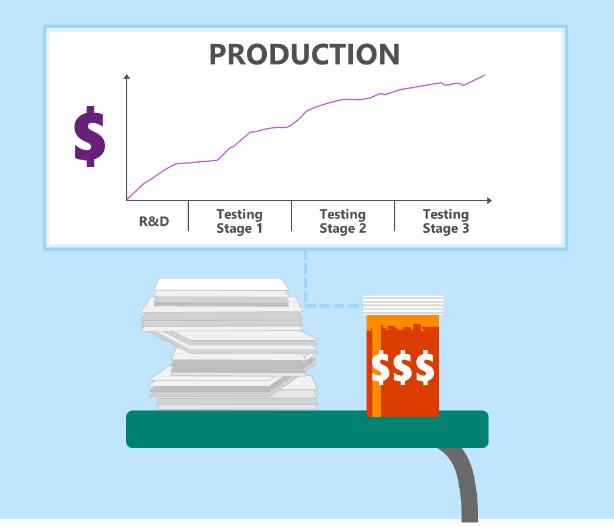
Diagnosing healthcare spending: the top 6 ways to increase efficiency in healthcare
The problem of wasteful spending in healthcare
Sometimes, it seems that healthcare spending is rising at uncontrollable rates. Over the past 20 years, global spending on healthcare has risen from 8.5% to nearly 10% of the Gross World Product. While worldwide health has improved during that time, there is nonetheless a constant tug-of-war between a desire to meet health goals and pressures to control spending. Decisions on healthcare spending present tremendously challenging and sensitive issues, as budget cuts and reallocations can cost patients their lives.
However, not all healthcare costs are correlated with better care. The healthcare industry is still struggling to eliminate wasteful practices that are rooted in habit, carelessness, or even intentional fraud. In order to get healthcare spending under control and improve quality of care, those in healthcare must pursue ways to improve efficiency and eradicate waste. Doing so requires an understanding of what drives wasteful spending.
Multiple studies estimate that over 20% of global healthcare expenditure is due to wasteful costs that are not actually associated with better care. Here, we break down six major ways that the healthcare industry can reduce wasteful spending and increase efficiency of care.
1. Identify cases of overtreatment
 When physicians do not act on best practices and provide excessive treatments for their patients, the result is expensive and often harmful. For example: prescribing antibiotics for viral infections or resorting prematurely to surgery for back pain are wasteful and careless practices that consume healthcare budgets without leading to better health outcomes. Often, overtreatment is the result of carelessness or ignorance of best practices on the provider’s part. But sometimes, providers intentionally over treat patients in order to turn a greater profit.
When physicians do not act on best practices and provide excessive treatments for their patients, the result is expensive and often harmful. For example: prescribing antibiotics for viral infections or resorting prematurely to surgery for back pain are wasteful and careless practices that consume healthcare budgets without leading to better health outcomes. Often, overtreatment is the result of carelessness or ignorance of best practices on the provider’s part. But sometimes, providers intentionally over treat patients in order to turn a greater profit.
Today, some providers are working to combat the overtreatment epidemic by taking part in movements like the Choosing Wisely Campaign. The group identifies and spreads information to providers about common, unnecessary treatments that should be avoided.
2. Reduce clinical errors
 Everyone makes mistakes – and mistakes in the hands of medical professionals have the potential to be deadly. Procedures and treatments that are supposed to heal can result in serious complications when established practice guidelines are not followed – such as surgical site infections and incorrectly-prescribed medications. Mistakes such as these are life-threatening, expensive, and far too common – one in ten patients is adversely affected during treatment by preventable errors, and more than 10% of hospital spending is allocated to correcting such harm. While we can never eliminate all errors in medicine, disseminating and enforcing measurable best practices can significantly improve the safety of healthcare delivery.
Everyone makes mistakes – and mistakes in the hands of medical professionals have the potential to be deadly. Procedures and treatments that are supposed to heal can result in serious complications when established practice guidelines are not followed – such as surgical site infections and incorrectly-prescribed medications. Mistakes such as these are life-threatening, expensive, and far too common – one in ten patients is adversely affected during treatment by preventable errors, and more than 10% of hospital spending is allocated to correcting such harm. While we can never eliminate all errors in medicine, disseminating and enforcing measurable best practices can significantly improve the safety of healthcare delivery.
3. Strengthen care coordination
 In most healthcare scenarios, patients are being treated by more than one person: this could include multiple doctors, nurses, home care providers, and more. This is especially true of chronic care patients who visit multiple specialists. When care is not fully coordinated, harmful mistakes can result: miscommunication between physicians can lead to improper diagnoses, harmful drug interactions, and more. Half of healthcare-related communication errors occur during handoffs between providers. Failures of care coordination harm the patient and add to the expense of healthcare. By investing in better technologies and practices to deliberately organize care efforts and tear down communication barriers has a tremendous impact on improving patient care and reducing readmissions.
In most healthcare scenarios, patients are being treated by more than one person: this could include multiple doctors, nurses, home care providers, and more. This is especially true of chronic care patients who visit multiple specialists. When care is not fully coordinated, harmful mistakes can result: miscommunication between physicians can lead to improper diagnoses, harmful drug interactions, and more. Half of healthcare-related communication errors occur during handoffs between providers. Failures of care coordination harm the patient and add to the expense of healthcare. By investing in better technologies and practices to deliberately organize care efforts and tear down communication barriers has a tremendous impact on improving patient care and reducing readmissions.
4. Simplify administration
 Anyone who has worked in the healthcare industry can tell you about the headache-inducing complexity of healthcare administration. In the US, a multitude of private insurers, each with different payment practices, contributes to this problem. Furthermore, government rules and regulations that are designed to help can cause a lot of pain in the process. Burdensome administrative requirements that are designed to reduce errors and stamp out fraud sometimes lead to more pain than they are worth by requiring physicians to jump through time-consuming hoops without evidence-backed effects on outcomes. The expenses of healthcare administration is a classic case of wasteful spending, as there is no apparent link between higher administrative costs and better-quality care.
Anyone who has worked in the healthcare industry can tell you about the headache-inducing complexity of healthcare administration. In the US, a multitude of private insurers, each with different payment practices, contributes to this problem. Furthermore, government rules and regulations that are designed to help can cause a lot of pain in the process. Burdensome administrative requirements that are designed to reduce errors and stamp out fraud sometimes lead to more pain than they are worth by requiring physicians to jump through time-consuming hoops without evidence-backed effects on outcomes. The expenses of healthcare administration is a classic case of wasteful spending, as there is no apparent link between higher administrative costs and better-quality care.
One of the most straightforward ways to simplify administration and trim excessive spending is increasing standardization of processes between diverse providers and payers. For example, credentialing and other systems that are used to establish contracts between providers and health plans are filled with redundancy. Standardizing administrative processes could save as much as $29,000 per physician annually.
5. Accelerate medical research efforts to reduce prices
 Particularly in the United States, the prices of prescription drugs are all too often prohibitive for those who need them. When patients cannot afford to take their prescriptions, their health is put in jeopardy, and they are more likely to require even more costly treatment down the line. One factor that contributes to prohibitively high prices is the fact that new devices or pharmaceuticals usually have a lengthy research and development process. For manufacturers, this means years of rising production costs, followed by a narrow window of opportunity to market the item before the patent protection lapses. This can result in seemingly exorbitant initial prices. Advances in faster and more effective analytical methods for drug and device testing could speed up the process of identifying successful treatments and eliminating harmful ones. In turn, this would allow pharmaceuticals and devices to get to market more quickly, ultimately reducing costs.
Particularly in the United States, the prices of prescription drugs are all too often prohibitive for those who need them. When patients cannot afford to take their prescriptions, their health is put in jeopardy, and they are more likely to require even more costly treatment down the line. One factor that contributes to prohibitively high prices is the fact that new devices or pharmaceuticals usually have a lengthy research and development process. For manufacturers, this means years of rising production costs, followed by a narrow window of opportunity to market the item before the patent protection lapses. This can result in seemingly exorbitant initial prices. Advances in faster and more effective analytical methods for drug and device testing could speed up the process of identifying successful treatments and eliminating harmful ones. In turn, this would allow pharmaceuticals and devices to get to market more quickly, ultimately reducing costs.
6. Fight fraud and abuse
 Finally, an appalling 6-7% of healthcare spending around the globe is lost to fraud and abuse every year. This is most often perpetrated by providers billing for their services incorrectly. This could take the form of adding nonexistent treatments or goods to a claim, or billing for more expensive services than those actually provided. As a result, funds are siphoned away from patient care and are pocketed illegally by providers.
Finally, an appalling 6-7% of healthcare spending around the globe is lost to fraud and abuse every year. This is most often perpetrated by providers billing for their services incorrectly. This could take the form of adding nonexistent treatments or goods to a claim, or billing for more expensive services than those actually provided. As a result, funds are siphoned away from patient care and are pocketed illegally by providers.
Fraud and abuse is difficult to detect: it takes many forms, and most of the money lost to fraud and abuse is due to widespread, low-level scams rather than large, complex schemes. Auditors just don’t have the resources to take on the task of screening out all fraud manually. They need precise, data-driven tools that have the power to automatically identify aberrant claims and focus the auditor’s attention on the most important cases for review.
Fighting fraud, waste, and abuse with powerful analytics
In order to free up life-saving money for treatment, every party involved in the healthcare process needs to chip in to fight wasteful practices. In particular, healthcare payers are on the front lines of preventing healthcare fraud, waste, and abuse (FWA), and thus are tasked with screening claims for signs of improper payments. With powerful, data-driven tools that can detect historical trends and identify anomalies, auditors can spot FWA and ensure that improperly paid claims are returned.
CGI ProperPay for claims analytics, built on Microsoft cloud technology, is an industry-leading claims screening solution that can help healthcare payers to preserve funds and fight wasteful spending. CGI ProperPay leverages the cutting-edge analytics abilities of Cortana Intelligence Suite to identify improper payments, and stores all data on the highly secure Azure cloud. Better screening tools will help auditors to identify fraud and abuse, as well as call out cases of overtreatment and wasteful excess. By taking advantage of advances in analytics and cloud technology, healthcare payers can now enhance their fight against wasteful spending and further the goal of making healthcare more accessible and affordable for all. Find out more about the powerful CGI ProperPay solution on Microsoft’s AppSource marketplace.




